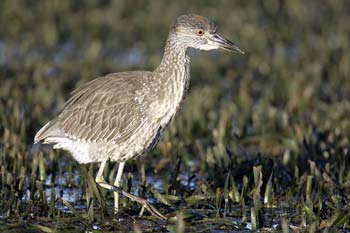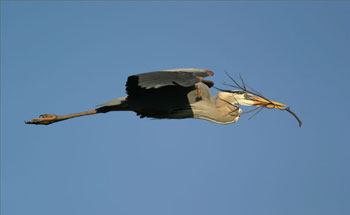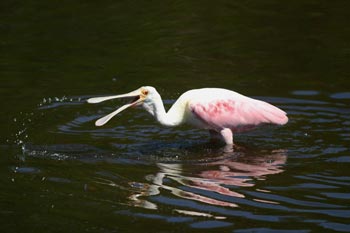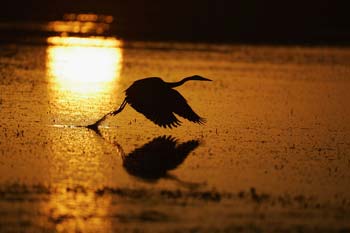
Copyright © Andy Long
Honeymoon Island in Dunedin is probably the best spot in the country for osprey photography.
If you mention to people that you’re headed to Florida for a bird photography trip, lots of possible destinations might enter their minds. There has always been Sanibel / ‘Ding’ Darling near Fort Myers, Corkscrew Preserve, the Venice Rookery, and–for the last several years–the Alligator Farm near St. Augustine. But Pinellas County–with St. Petersburg, Clearwater and Dunedin–ranks up there with the top bird photography locations in the country, and not at just one time of the year.
No matter when your trip is scheduled, you can find great bird photography waiting along the three coastlines, the countless lakes, and many creeks and sloughs. Three coastlines? Yes, Pinellas County is a peninsula on the Gulf Coast–one of the few places in the country where you can catch the sun rising and setting with water in the photo. The extra shoreline also provides more bird opportunities.
Numerous years back, the Florida Fish and Wildlife Conservation Commission came up with the Great Florida Birding Trail. Booklets that highlight each portion of the state are available, and the West Section booklet that includes this area designates fifteen spots in the county as good places to go for bird viewing / photography. (Take it from someone who was born in St. Petersburg; there are many more places than just these fifteen in which to find great bird photography.)

Copyright 2007 Andy Long
Searching around the county will provide some unique finds, such as this bittern.
Several spots might already be familiar to bird photography enthusiasts. Honeymoon Island in Dunedin is probably the best place in the country for nesting osprey. Typically, there are about fifteen nests in the area, so no matter what time of day you go, there’s a nest that works well with the prevailing light and wind direction. (You’ll want to have both the sun and wind at your back for shots of birds taking off from and landing at the nests.) While you’ll find osprey here in any season, nesting takes place in March and April. At other times of the year, you can usually spot them flying overhead or sitting perched on a branch eating fish from the nearby waters.
The most popular spot in the county is, by far, Fort DeSoto State Park at the southern tip of the county. Even on a bad day, you’ll find something to photograph. On a good day, you won’t want to leave even when the light is gone or you need to find something to eat, because the action can be non-stop from sunrise to sunset. The variety of birds is also unmatched. During a workshop here in 2006, one participant said he didn’t think his shots included a huge variety of birds, but when he looked through his images, he found he had more than thirty species. And those were merely the subjects he shot. There were probably many more songbirds and small shorebirds that didn’t get their photos taken. Nearly every species of wading bird, tern, gull, and shorebird is here year-round.

Copyright © Andy Long
Great blue herons nest all around the county. Find a nest and sit around and you’re sure to find some great action.
Also at Fort DeSoto, there’s a healthy population of the endangered piping plover. You’ll probably find them at least once per trip to the park in areas at both the North and East Beaches. For those interested in songbirds, especially during migration seasons, the Mulberry Tree is a must-visit spot. At different times of the year, more than a hundred varieties of birds make their way through this area. There are a couple of benches for sitting back and watching the action. (To get to the tree, park on the east side of the parking lot at the south fishing pier, and walk east behind the residence. You can’t miss it.)
Another top spot in the county that is cited in the guide is Sawgrass Lake Park. In this area, the sun takes a while to rise high enough for good light. First-time visitors are surprised to discover that on the east side of the park, the trail is less than fifty yards from an interstate. The birds don’t seem to mind, though, as they have become so accustomed to the noise that they sit like statues along the slough waiting for small fish to swim by. While most birds located here can be found other places, as well, the chances for capturing a less common subject such as a green heron are pretty good if you look carefully along the shore.

Copyright 2007 Andy Long
Fort DeSoto and Weedon Island are great spots to find roseate spoonbills.
Do you want to shoot a truly unusual sight? There’s a house in a residential area of St. Petersburg that has become a wood stork haven. Every afternoon, a group of about fifty of these threatened birds converges on the roof of the house, in the yard, and in the trees. It’s a sight you’ll never forget. (You have to go to my workshop to see where the house is located.)
Pinellas County is also one of the best places to photograph black skimmers. Nesting takes place in at least a half-dozen spots along the beaches. In 2007, the largest colony had 550 nests. These year-round residents can regularly be found at Fort DeSoto, Sand Key in Clearwater, Belleair Beach, Indian Shores, and on Egmont Key. One spot at Fort DeSoto acts as a staging area in the morning and evening for the comings and goings of the skimmers. Watching and waiting, you can get great photos of them bathing and then taking off from the water as they move back onto a nearby sandbar. Skimming can also be observed in this area.
Besides all of the typical waders, shorebirds, terns, and gulls, a large selection of ducks and other waterfowl await your camera at lakes all over the county. While the state of Minnesota is called “the Land of 10,000 Lakes,” Pinellas County has hundreds of lakes that all attract birds. You can’t drive for a mile around neighborhoods without finding another lake with something interesting to photograph.

Copyright © Andy Long
Both sunrise and sunset shots can be taken at Fort DeSoto, where getting great sunrise colors with herons or egrets silhouetted, is not a hard shot to find.
One spot that is more than a sight to behold is the rookery island at Coffee Pot Bayou. This mangrove island puts the Venice Rookery to shame in that at the peak of its activity, there are nearly 600 pairs of nesting birds–including reddish egrets, herons, great egrets, pelicans, and more. You’ll need a boat to work this small island, but you can see it from the road that passes just a little too far away for photography.
A look through the Birding Trail guidebook will suggest numerous other spots where you can discover great photo ops, but taking time to work the beaches and shorelines around Pinellas County will keep any bird photographer busy. You can also explore the lakes, canals, sloughs and other spots where birds have found a place to call home.
by Andy Long

Read your article with interest. I would be interested in Bird Photography Tours or workshops that you organize. Please contact me with your winter 2018 and spring 2019 schedule.